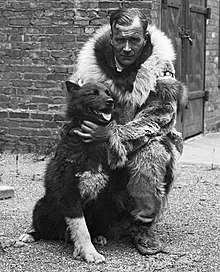Balto
Balto (* around 1919 ; † March 14, 1933 ) was a Siberian Husky who became world famous as the lead dog of the last sled dog team in the serum Run to Nome 1925. Balto was the lead dog of Gunnar Kaasen's team , who completed the last leg of the relay race from Nenana to Nome, Alaska .
Diphtheria epidemic in Nome
In January 1925, diphtheria broke out in the small town of Nome in western Alaska . The predominantly Indian population had not developed any antibodies against this disease and was therefore seriously threatened. Several children had already fallen victim to the disease within a very short time.
The serum that was supposed to stop the disease was in Anchorage , nearly 1,000 miles (1609 km) away. Since there were no roads to Nome and the few planes could not fly in the dark and bad weather, it was decided to go with a sled dog relay.
A total of 20 mushers and their teams took part in the relay, which was supposed to bring the serum to Nome as quickly as possible. The weather was extremely bad, the teams struggling with temperatures of -23 ° F (-31 ° C) and strong winds. Radio stations around the world reported constantly on the progress of the relay - the telegraphs were working perfectly.
Gunnar Kaasen and his team were scheduled to be penultimate, but had missed Solomon because of the bad weather - Kaasen later said he had barely seen his hand in front of his eyes - and drove straight to Nome without looking for Ed Rohn, who was actually the last stage should have started. On February 2, 1925, at 5:30 am, Balto reached Front Street in Nome, Alaska.
Aftermath

After the race, Kaasen and Balto became stars. The press pounced on the two and President Calvin Coolidge also praised the act. However, there was also criticism: Leonard Seppala in particular , who had actually covered the most difficult and longest distance, accused Kaasen of claiming all the fame for himself. Togo , the lead dog of Seppala, was only given the due honor later.
The well-known sculptor Frederick Roth created a statue of Balto, which was erected in Central Park in the middle of New York on December 17, 1925, just 10 months after the heroic deed .
The inscription on the monument reads:
"Dedicated to the indomitable spirit of the sled dogs that relayed antitoxin six hundred miles over rough ice, across treacherous waters, through Arctic blizzards from Nenana to the relief of stricken Nome in the Winter of 1925
Endurance · Fidelity · Intelligence"
“Dedicated to the indomitable will of the sled dogs, which made them carry an antidote six hundred miles over rough ice, through treacherous waters and arctic blizzards from Nenana in the winter of 1925 to alleviate the afflicted Nome.
Perseverance · loyalty · intelligence "
Balto spent the period from March 1927 until his death in 1933 at the Cleveland Zoo , Ohio . After his death, it was stuffed and has been on display at the Cleveland Museum of Natural History for most of the time .
On December 22, 1995, the animated film Balto premiered by Universal Pictures . The film is loosely based on the events of 1925. Universal also made two direct-to-DVD cartoons about Balto.
Individual evidence
- ^ Gay Salisbury, Laney Salisbury: The Cruelest Miles: The Heroic Story of Dogs and Men in a Race against an Epidemic . WW Norton & Company, New York 2003, ISBN 0-393-01962-4 , p. 187.
- ^ Balto , New York City Department of Parks & Recreation. Retrieved on May 24, 2017
- ^ Balto , Central Park Conservancy: Official Website for Central Park. Retrieved May 24, 2017
- ↑ Balto. In: Encyclopedia of Cleveland History. Retrieved May 24, 2017 .

